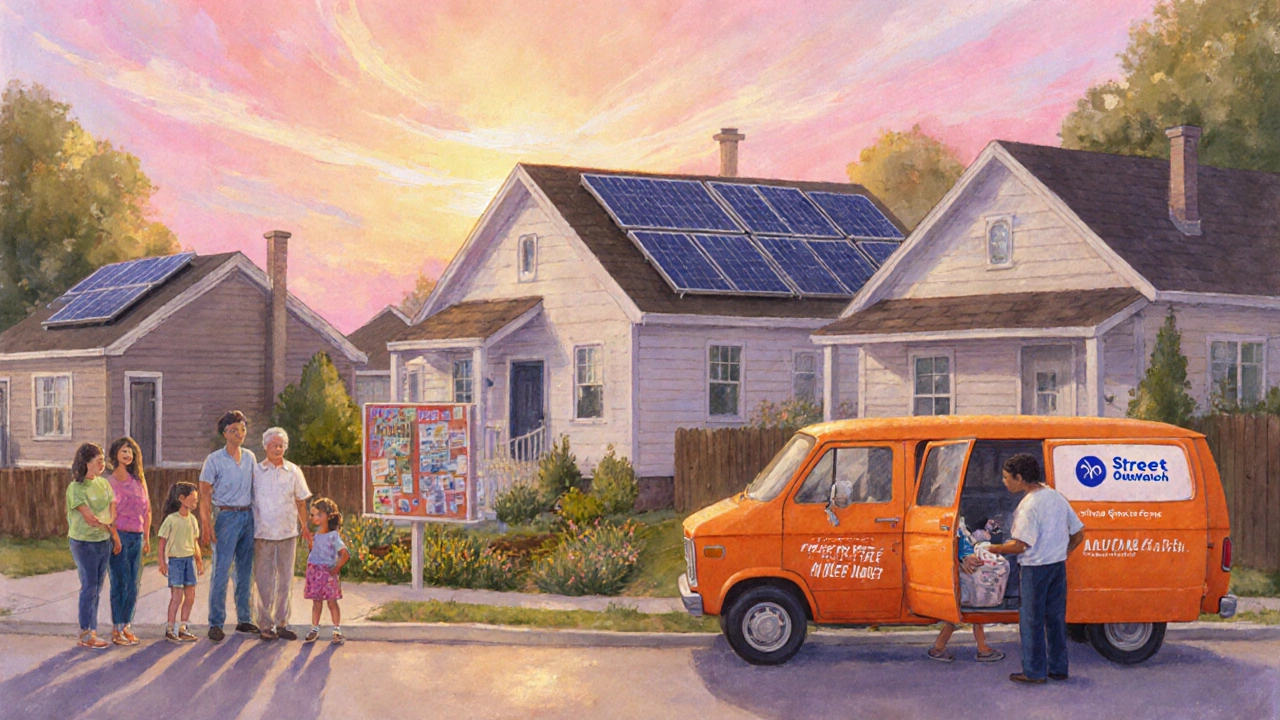Top Successful Homeless Programs: What Works Best
 Oct, 25 2025
Oct, 25 2025
Homeless Program Matchmaker
This tool helps community leaders and service providers select the most effective homeless program model based on your specific circumstances. Answer the questions below to identify the best solution for your community.
How It Works
This tool uses evidence-based criteria from successful homeless programs to recommend the most appropriate model for your community. It considers:
- Population needs
- Funding availability
- Existing service capacity
- Primary objectives
Finding the right mix of housing, support, and community engagement can turn a struggling outreach effort into a thriving solution. Below we break down the programs that consistently deliver lasting stability for people experiencing homelessness.
What Defines a Successful Homeless Program?
Success isn’t just about filling beds; it’s about keeping people housed, improving health, and building pathways to independence. The most reliable indicators include:
- Housing retention rates above 70% after two years
- Reduced use of emergency services and shelters
- Increased employment or income stability
- Improved mental‑health and substance‑abuse outcomes
Programs that meet these metrics tend to share three core ingredients: immediate, permanent housing; wrap‑around supportive services; and a flexible, client‑centered approach.
Housing First
When tackling homelessness, Housing First is a policy approach that provides immediate, permanent housing without preconditions, followed by supportive services that address health, employment, and social connections. The model started in the United States in the 1990s, spread to Canada and Europe, and now powers more than 2,000 projects worldwide.
Key strengths include:
- Clients keep their housing even if they relapse into substance use.
- Service providers focus on voluntary participation, which boosts trust.
- Retention rates often exceed 80% after three years.
In Melbourne, the Housing First Australia network reported a 78% two‑year retention rate across 12 sites, cutting emergency department visits by 42%.
Rapid Re‑Housing
Rapid Re‑Housing offers short‑term rental subsidies and intensive case management to move people quickly from shelters into stable housing. Unlike traditional public housing, the voucher period usually lasts 12‑24 months, giving families time to rebuild credit and secure employment.
Success factors include:
- Fast placement-average move‑in time under 30 days.
- Case managers who coordinate utility set‑up, job training, and health referrals.
- High turnover of vouchers, allowing programs to serve more households.
Boston’s Rapid Re‑Housing Initiative saw a 65% rate of households staying housed after the subsidy ended, outperforming the city’s traditional public housing placement rate of 38%.
Permanent Supportive Housing
Permanent Supportive Housing combines long‑term affordable housing with on‑site social services for people with chronic health conditions. Funding typically blends federal, state, and private sources, allowing rent to stay below 30% of income.
Why it works:
- Residents receive 24‑hour access to health nurses, mental‑health counselors, and employment coaches.
- Facilities are built to be trauma‑informed, reducing turnover.
- Program costs per resident are often lower than the cumulative cost of emergency shelter, jail, and hospital stays.
A 2023 study by the National Alliance to End Homelessness found a 60% reduction in public‑cost expenditures for participants after moving into permanent supportive housing.

Community Land Trusts
Community Land Trust is a nonprofit model that acquires land and holds it permanently, allowing affordable homes to be built on that land while the structures can be sold or rented. The land stays community‑owned, protecting residents from market spikes.
Impact highlights:
- Homeownership rates among formerly homeless families rise to 55% within five years.
- Neighborhood stability improves, with crime rates dropping 12% in trust‑managed blocks.
- Funds are leveraged-each dollar of grant money can unlock up to $5 of private investment.
The Burlington, Vermont Community Land Trust turned a vacant industrial lot into 30 affordable homes, moving 70 previously homeless individuals into ownership.
Street Outreach Services
Street Outreach Services deploy mobile teams of health workers, social workers, and peer mentors to engage people living on the streets where they are. Outreach is often the first point of contact that guides individuals into shelter or housing programs.
Core advantages:
- Trust is built through consistent, non‑judgmental presence.
- Teams can deliver vaccinations, basic hygiene kits, and crisis counseling on the spot.
- Data collection helps agencies map hotspot locations and allocate resources efficiently.
Seattle’s Street Outreach Corps reported that 42% of people they engaged entered a housing pathway within six months, a jump from the city’s baseline 18%.
Comparison of Leading Homeless Programs
| Program | Housing Type | Average Retention (2 yr) | Key Service Focus | Typical Funding Source |
|---|---|---|---|---|
| Housing First | Permanent apartments | 80 % | Voluntary case management, health | Federal grant + local levy |
| Rapid Re‑Housing | Short‑term rentals | 65 % | Voucher subsidies, intensive casework | Housing vouchers, charitable gifts |
| Permanent Supportive Housing | Affordable units with services | 75 % | 24‑hour health and employment support | Mixed public‑private financing |
| Community Land Trust | Owned land, affordable homes | 55 % homeownership | Land stewardship, homebuyer counseling | Grants + private equity |
| Street Outreach | None (mobile teams) | 42 % entry to housing pathways | Health services, trust‑building | Municipal budget + NGOs |

Implementing a Program in Your Community
- Conduct a local needs assessment - gather data on homeless demographics, shelter capacity, and service gaps.
- Choose a model that aligns with the identified gaps - for example, if chronic health issues dominate, Permanent Supportive Housing may be best.
- Secure funding - combine government grants, philanthropic donations, and social‑impact investments.
- Partner with existing service providers - health clinics, employment agencies, and legal aid groups enhance the support network.
- Hire or train a multidisciplinary case‑management team - ensure staff understand trauma‑informed care.
- Set clear performance metrics - track retention, health outcomes, and cost savings.
- Iterate based on data - adjust housing mix, service intensity, or outreach tactics as needed.
Following these steps can help local nonprofits and municipalities launch a program that delivers measurable, long‑term impact.
Common Pitfalls and How to Avoid Them
Even proven models stumble when they ignore local context. Typical mistakes include:
- Relying on a single funding stream - diversify to protect against budget cuts.
- Imposing strict sobriety rules - under Housing First research, flexibility boosts retention.
- Neglecting after‑care - without ongoing support, many residents fall back into homelessness after two years.
- Overlooking community resistance - engage neighbors early, share success stories, and involve them in planning.
Addressing these issues early keeps the program running smoothly and builds trust.
Quick Checklist for Evaluating Program Success
- Retention rate above 70% after 24 months?
- Clients report improved health and employment?
- Public‑cost savings documented?
- Stakeholder (clients, staff, community) satisfaction high?
- Funding sources stable and diversified?
If the answer is yes for most items, you’re likely looking at a successful homeless programs model.
Frequently Asked Questions
What is the main difference between Housing First and Rapid Re‑Housing?
Housing First provides permanent apartments with no preconditions, while Rapid Re‑Housing offers short‑term subsidies to help people quickly move into market rentals, usually for one to two years.
Can Community Land Trusts be used in urban areas?
Yes. Many cities convert underused parcels or former industrial sites into trust‑held land, keeping homes affordable for decades.
How do I measure cost savings from a homelessness program?
Compare the program’s operating costs with the combined expenses of emergency shelter, hospital, and criminal‑justice services that the participants would have otherwise incurred.
Are there federal grants available for Permanent Supportive Housing?
The U.S. Department of Housing and Urban Development (HUD) offers Continuum of Care (CoC) funding, and Canada’s Housing Solutions Initiative provides similar support.
What training do street outreach workers need?
Training typically covers trauma‑informed communication, basic medical triage, cultural competency, and safety protocols for working in high‑risk environments.